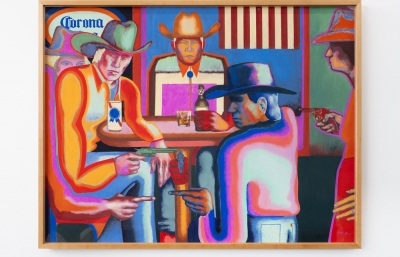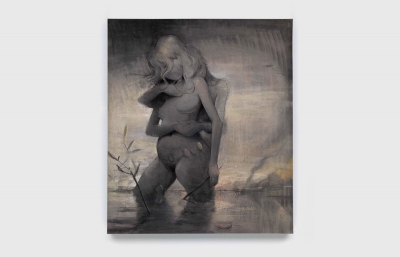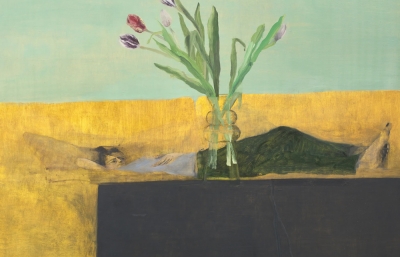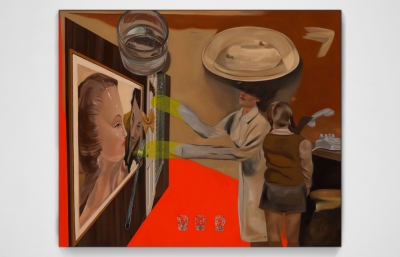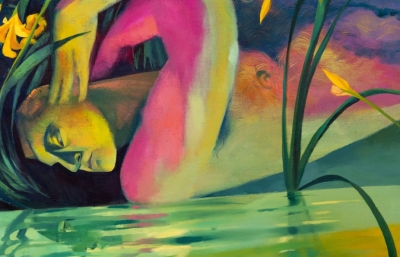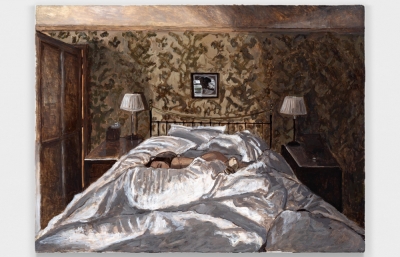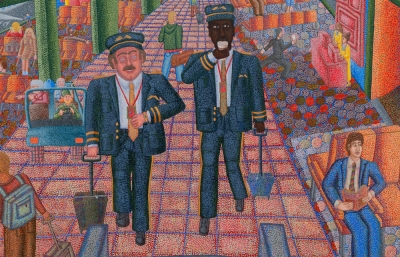Fame came calling a little late in the day for the London-based artist, Benjamin Spiers, the former art instructor directly responsible for the development of Oli Epp's distinctive visual language (as confirmed by both parties). But it wasn’t until Epp shared Spiers’s personal paintings with the art world that the cognizenti started paying attention. With a trove of innovative works he'd created over previous years, Spiers’s solo debuts in London and LA in 2019 were an instant success, leaving everyone hungry for more.
The exciting way he applies the meticulous Realist technique onto Surreal, Cubist, or even, Abstract imagery is an obvious reason to enjoy the works, but the insight gleaned from our conversation deepens this appreciation. Purposefully targeted, each oversaturated discoloration, anatomic exaggeration and textural glitch is part of Spiers's complex equation, which results in profound and beguiling visuals that successfully bridge the gap between classic and contemporary in rare form.

Sasha Bogojev: It's the day after your show opening, and we’re speaking about your career, which has spiraled pretty quickly. How does that feel?
Benjamin Spiers: It’s been so quick, and obviously exciting and amazing! Slightly terrifying. I had spent so many years in the studio working, developing my technique and my ideas, that I was able to incubate for a long, long time without external pressure. So, in a weird way, it's like I'm super prepared for it.
It feels like that to me, as well.
The thing is, the external pressure is scary sometimes, and it feels like there’s no allowance for paintings to fail. But, it also focuses my mind. It used to be that one in every five paintings wouldn't work. But now, pretty much every painting works. The pressure has helped clarify my ideas before I embark on making the paintings. It's novel and exciting.
That's actually what I was going to ask. How did that affect the process? Because you were talking about how much more decisive you've become.
That's right. One of the things I've realized about working on one’s own all the time—without an external context—is that you just spend too long polishing a painting. Making sure that every little aspect is completely perfect. I’ve realized I don't need to do that. In fact, it can be unhelpful. The most important thing is that the idea is expressed clearly and strongly.

Speaking of being fastidious, the first time we got in touch was before the LA show and you were explaining how precise you are and how much layering goes into every inch of the surface. So, did that actually change in such a short period of time?
I'm still pretty damn fastidious! When I look at my paintings, I can be properly critical. However, now the work is snatched out of the studio pretty quickly, so I can’t do that self-critical thing so much. I think that's really healthy for the work and for my sanity. The technique's still there, but it's more focused, and I'm much quicker.
You’re more purposeful?
Exactly. But that sense of purpose doesn’t only come from within. It’s generated in response to poetry, movies or other works of art. I have so much fun trying to bring together my love of David Lynch or Tarantino films with 14th-century Italian painting, with a bit of Caravaggio here, some Picasso there. It might be boring if it was just a collage, but I filter it all through my internal process.
Now that you mention influences, I guess most evident to everyone would be Cubism? Is it Picasso or is it Cubism in general?
I think Cubism offered me a really, really interesting kind of structure to reinvent. Okay, I'm going to take a roundabout way of answering this. If you're painting a very realistic figure, people instantly kind of key into whether it's anatomically accurate. So if you don't get a hand right, people see it. You can intentionally distort things, but you're very much bound to a template that everyone has in their mind when they look at something—and I do like that sometimes. But the thing about Cubism is that it's already so fractured that the expectations are set aside. It allowed me to think about space and figures very differently. It really freed me up to be more playful.

Tell me about the strange hands and fingers.
I have got quite weird double-jointed fingers that bend backward, not unlike those in my pictures! Aesthetically, I just find it really fascinating when fingers are kind of reaching out and bending back at the same time. You see it a lot in Japanese prints, particularly in Shunga. There's a suggestion of sexual ecstasy. It's so rapturous that the fingers are bending back on themselves, everything's curling up in pleasure!
Their color changes, too!
We know a lot of the world through the use of our hands, in terms of sense of touch, but also in terms of our experience with tactility and the different textures of things and communicating through gestures, but also bonding with other people. That sense of touch is massively important. I think we're primed to see hands as conduits of communication, even as they are in that natural form. But somehow heightening that communication with distortion, for me, is another vehicle to express ideas really strongly.

Freckles, Oil on linen, 12” x 16”, 2017
Now I'm self-conscious about my hands! You referenced the sensuality of Japanese works. There's definitely a lot in yours, the nude females being the most obvious.
Sex is a huge part of identity and our experience of the world. It shapes interactions in ways that are exciting, but also complicated.
And how do the super skinny subjects come into the picture?
A lot of the time, the starting point for my work will be another artist's work. So, for instance, both of the very skinny figures in this show are based on Egon Schiele drawings. Succession, which initially started as a male figure, is based on an Egon Schiele self-portrait.
So Nude Nun isn't just a way of trying to create a provocative image?
Obviously, it's really provocative and I enjoy the provocation, but for me, it’s also open-ended and ambiguous. I take a lot of pleasure in that ambiguity. I really love things that are very strongly themselves, but at the same time, don't resolve into something that's readily digestible.

Another thing I noticed is the attention to musculature in some of the works. You clearly enjoy depicting anatomy.
Oh, love it! It's tremendously enjoyable working, thinking about how the human body works. What muscle attaches to what joint and trying to make sense of that.
You like to exaggerate them a fair bit.
I often distort things, but actually, I think one of the reasons that I can distort them convincingly is that I actually understand reasonably well how it works in reality. The most important thing isn’t accuracy, but that it is convincing, or believable—that it draws you in.
When you said believable, I definitely get that with the dog image. It looks real, but so surreal at the same time. Though it's not possible, as you look at it, you find yourself wondering where did he find a picture of such a dog like this?
Exactly! The form is articulated very precisely. It has to be for the viewer to suspend their disbelief. You're looking at this thing that's simultaneously real and not real.

Do you regularly borrow from other work, and how do you feel about people making note of this?
Absolutely, any painting is in a dialogue with other painters: living painters talking about other dead painters, engaging with their work, taking things from one painting and trying to reconfigure it. I sort of feel like I'm squarely in that tradition. The game of “spot the influence” is not massively interesting in itself, but it can be fun.
Do you ever get stuck, without a way to resolve the blend of influences?
Less so these days, but I used to abandon a lot of work because I couldn’t find a way to synthesize the disparate elements.

Since it sounds like most of it happens as you make it, how much do you prepare in advance?
I don't start painting until I've got a fairly clear idea of what I want to do; but a lot of things can and do change. I do make preparatory drawings, and I've had phases where I've done very precise drawings, though not so much anymore because improvisation brings so much energy to the work. There's gotta be something at stake, a sense that it could all go wrong. It’s like a film where everything spins out of control at the start and then the rest of the movie is devoted to coming up with creative ways of weaving the threads back together.
I love that analogy. So how do you get yourself out of that pickle?
A combination of luck, practice, and unreasonable determination!

